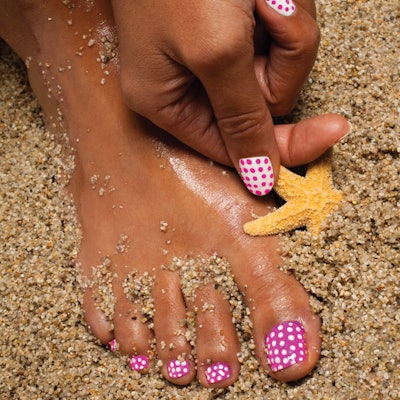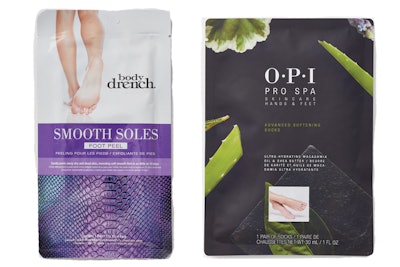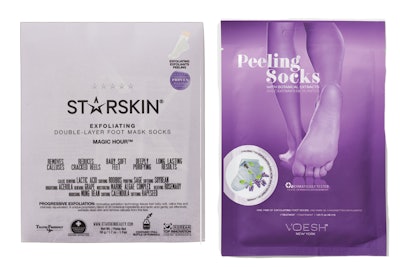
After months stuffed in socks and boots, your clients’ neglected feet may be in desperate need of a sandal-worthy extreme makeover—but it’s important to remember that each client’s needs are unique. Fortunately, there are a number of exfoliation techniques available to remove dry, dead skin and reduce calluses, revealing softer feet beneath. But the benefits of exfoliation don’t stop there. “Exfoliation helps with cellular turnover, encourages microcirculation and prepares skin for better product penetration,” says Nikki Fraser, educator for Footlogix.
Why is exfoliation necessary? “The outermost layer of skin is made of keratinous cells held together by lipids, kind of like tiny roof shingles held together by glue,” explains Morgan Taylor educator Danielle Candido. “They act as protection for the new skin just below.” If the skin is repeatedly exposed to pressure or rubbing, the body’s natural defense is to build up an even thicker layer of protection, resulting in a callus. “Generally, calluses aren’t harmful. However, if the buildup continues, other complications can arise,” says Candido. Deep cracks in the skin are not only painful, but also can be portals of entry for pathogens, which can lead to infection.
“Since every skin type is different, it’s important to exfoliate safely using the proper method,” says Gena master educator Kimberly Woodard. Many factors, from a client’s skin sensitivity to her age to her health, will impact which exfoliation method is ideal—and often, a combination of techniques is the best fit.
Manual Exfoliation
There are two main exfoliation methods. The first, manual or physical exfoliation, uses a rubbing or scrubbing action to remove dead skin and calluses. Manual exfoliation tools, such as foot files, pedicure bits and pumice stones, can significantly reduce skin buildup in a single pedicure visit. But because tools can be aggressive, they should only be used on the bottom and sides of the feet.
Most effective after the feet have been soaked, foot files are the manual tool of choice for many techs. Fraser uses an all-metal, stainless steel foot file because it can be disinfected and sterilized. “I recommend an etched file so that the abrasive surface remains intact,” she says. “A glued on-grit runs the risk of coming off.” Single-use files are another option. They come in a variety of grits, and techs frequently choose them for convenience to maintain proper sanitation.
RELATED: More Than 2,200 Nail Professionals Attended NAILPRO Pasadena
While not all techs are comfortable using an electric file on client’s feet, Vicki Malo, president of the North American School of Podology, maintains that they’re a safe and effective exfoliation tool when used correctly. “No one should be using an electric file on the feet without training on how to use it properly,” she says. She cautions techs to always choose bits that are specifically designed for use on the skin and never use bits designed for natural nails or enhancements. Use an e-file on dry feet and periodically check with the client to ensure that she’s not experiencing any heat or discomfort.
This should go without saying, but razors, Credo blades or grater-type tools should never be used. Not only are they dangerous and illegal in many states, but cutting skin goes beyond the scope of nail technician’s license. “These tools can be extremely damaging and are far too aggressive to be used in a pedicure service,” says Candido. If there are circumstances where these tools are necessary, the client should be directed to a licensed and specially trained foot care nurse or podiatrist.
Manual exfoliation can also be achieved with scrubs that contain small particles, such as sugars and salts, which act as an abrasive when rubbed onto the feet. “Scrubs alone don’t do much on the bottom of the feet because the skin is different,” says Malo, “but they will make a big difference on the top of the feet and legs.”
Chemical Exfoliation
Chemical exfoliation is achieved by applying ingredients to the skin that break down the bonds between the dead skin cells, helping the cells shed more easily, says Candido. “Clients with sensitive skin may benefit more from a chemical process, because too much scrubbing can irritate and cause inflamation,” she says. Still, it’s important to select products carefully, cautions celebrity manicurist Mar y Sol Inzerillo. “Avoid using a harsh chemical exfoliant on sensitive skin, and make sure you have options on hand,” she says. For sensitive clients, Inzerillo focuses chemical exfoliators only on especially dry and tough areas.
RELATED: How to Service Clients in Need of Toenail Reconstruction
Many ingredients, from acids to algae, can chemically aid exfoliation. Alpha hydroxy acids, or AHAs, such as citric, salicylic and glycolic acids, are derived from foods. “These acids change the pH of the skin, breaking down the lipids that hold onto dead skin cells, making it easier to slough off,” says Malo. Note that AHAs can cause photosensitivity, so be sure to tell clients to wear sunscreen when using them.
Fruit enzymes, like pumpkin, papaya and pineapple, gently exfoliate by breaking down the keratin protein found in dead skin at the surface, resulting in a smoother appearance. Urea, a natural by-product of protein metabolism, is unique because it not only loosens scaly, dead skin, making it easier to exfoliate, but it’s also an excellent hydrator.
Chemical exfoliants come in all forms—soaks, baths, scrubs, masks, lotions and serums—and may be combined with other ingredients, such as moisturizers. While very effective, chemical exfoliation is unlikely to give clients immediate, dramatic results; these products produce the best results over time and when used in combination with other exfoliation methods.
More Isn’t Always Better
A common exfoliation mistake is removing too much skin. “We get excited and want to help clients achieve the best outcome in a single visit,” says Malo. “But if you take off too much, the skin will react and bump up production. You want that fast turnover on your face or legs, but not on the bottom of your feet,” she says. Normal, dry skin should be hydrated, not removed.
Likewise, it’s especially important not to over-exfoliate the skin of senior citizens or people with diabetes, says Woodard. In these cases, maintaining the integrity of the skin is paramount and less aggressive exfoliation methods should be used. Aging and poor circulation make the skin thinner and more fragile, particularly on the bottom of the feet. “Over time, we lose the fat pads that once protected the feet from the trauma of walking,” says Malo. “Skin and calluses take over, and if over-removed, the client may find walking uncomfortable and can develop ulcerations, risking infection.”
“Every technician must ensure a good consultation with the client and be able to assess skin types in order to determine the best method,” says Woodard. “Most times, the best method or technique is a combination of techniques.” For example, start with a foot soak, followed by a chemical callus softener and a foot file. In most cases, regular professional pedicures and consistent home care will lead to the best results. Encourage clients to focus more on hydration and leave the heavy exfoliating for the professionals. “It’s helpful for clients who have a lot of buildup to exfoliate at home between appointments,” says Candido. “However, technicians must educate the clients on proper exfoliation so they don’t create a bigger problem. I recommend a sugar or salt scrub, as opposed to a foot file or pumice stone, because clients are less likely to exfoliate too aggressively.”
Retail Essentials
Stock up on these take-home tools that clients can use between visits to maintain smooth, soft skin.

Body Drench Smooth Soles Foot Peel
OPI Pro Spa Advanced Softening Socks

Star Skin Exfoliating Double-Layer Foot Mask Socks
Voesh Peeling Socks
–by Lisa Henry
This story first appeared in the June issue of Nailpro magazine. To receive the magazine, click here to subscribe.
[Images: Courtesy of Armando Sanchez]











